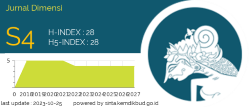ENDOGENOUS GROWTH FACTORS IN FOUR CATEGORIES OF COUNTRIES BASED ON HDI
Abstract
The economic slowdown is an issue that the global economy still faces since the 2007-2009 Great Recession. The decline in physical and natural capital will further exacerbate this slowdown. This study analyzes the factors driving growth based on endogenous growth theory using a case study of four country categories based on the Human Development Index (HDI) level to solve the economic slowdown problem and realize sustained economic growth as Goal 8 of Sustainable Development Goals (SDGs). The variables used in this study are HDI, Global Innovation Index (GII), labor force, and Gross Fixed Capital Formation (GFCF). This study analyzed 98 countries in 2011-2018 using Fixed Effect and Random Effect Model. The estimation results show that HDI, labor force, GII, and GFCF significantly affect economic growth in the very high, high, and medium HDI country categories. This study found that GII did not affect economic growth in the low HDI countries category.
Keywords
Full Text:
PDFReferences
Agénor, P. R., and Neanidis, K. C. (2015). Innovation, public capital, and growth. Journal of Macroeconomics, 44, 252-275.
Al-Zaroog, S. A. M., and Baqir, A. A. F. (2020). The Impact of Global Innovation on Economic Growth in Developing Countries. Journal of Social Sciences (COESandRJ-JSS), 9(2), 373-393.
Appiah, M., Amoasi, R., and Frowne, D. I. (2019). Human Development and its effects on Economic Growth and Development. International Research Journal Of Business Studies, 12(2), 101-109.
Brandt, N., Schreyer, P., and Zipperer, V. (2017). Productivity measurement with natural capital. Review of Income and Wealth, 63, S7-S21.
Cirera, X., and Maloney, W. F. (2017). The innovation paradox: Developing-country capabilities and the unrealized promise of technological catch-up. The World Bank.
Dutta, S., and Lanvin, B. (2012). The global innovation index 2012. Stronger innovation linkages for global. INSEAD, WIPO.
Dutta, S., and Lanvin, B. (2013). The global innovation index 2013: The local dynamics of innovation. Johnson Cornell University, INSEAD, WIPO.
Dutta, S., Lanvin, B., and Wunsch-Vincent, S. (2014). The global innovation index 2014: The Human Factor in Innovation. Johnson Cornell University, INSEAD, WIPO.
Dutta, S., Lanvin, B., and Wunsch-Vincent, S. (2015). The global innovation index 2015: Effective Innovation Policies for Development. Johnson Cornell University, INSEAD, WIPO.
Dutta, S., Lanvin, B., and Wunsch-Vincent, S. (2016). The global innovation index 2016: Winning with global innovation. Johnson Cornell University, INSEAD, WIPO.
Dutta, S., Lanvin, B., and Wunsch-Vincent, S. (2017). The global innovation index 2017: Innovation feeding the world. Johnson Cornell University, INSEAD, WIPO.
Dutta, S., Lanvin, B., and Wunsch-Vincent, S. (2018). Global innovation index 2018: Energizing the world with innovation. Johnson Cornell University, INSEAD, WIPO.
Goñi, E., and Maloney, W. F. (2017). Why don’t poor countries do R&D? Varying rates of factor returns across the development process. European Economic Review, 94, 126-147.
Gujarati, D.N. and Porter, D.C. (2019) Basic Econometrics. 5th Edition. New York: McGraw-Hill Companies.
Haller, A. P. (2014). Italy-Economic Growth and Human Development. Comparative Analysis. Procedia Economics and Finance, 15, 916-925.
Korkmaz, S., and Korkmaz, O. (2017). The relationship between labor productivity and economic growth in OECD Countries. International Journal of Economics and Finance, 9(5), 71.
Lange, G. M., Wodon, Q., and Carey, K. (Eds.). (2018). The changing wealth of nations 2018: Building a sustainable future. The World Bank.
Levine, R., and Renelt, D. (1992). A sensitivity analysis of cross-country growth regressions. The American economic review, 942-963.
Pece, A. M., Simona, O. E. O., and Salisteanu, F. (2015). Innovation and economic growth: An empirical analysis for CEE countries. Procedia Economics and Finance, 26, 461-467.
Pradhan, R. P., Arvin, M. B., Nair, M., and Bennett, S. E. (2020). The dynamics among entrepreneurship, innovation, and economic growth in the Eurozone countries. Journal of Policy Modeling.
Ridha, M. R., and Parwanto, N. B. (2020). The Effect of Foreign Direct Investment, Human Development and Macroeconomic Condition on Economic Growth: Evidence from Indonesia. Journal of Indonesian Applied Economics, 8(2), 46-54.
Ulas, E., and Keskin, B. (2017). Is There a Relation Between HDI and Economic Performances?. In New trends in finance and accounting (pp. 61-70). Springer, Cham.
United Nations. (2011). World economic situation and prospects 2011. New York: United Nations Publication.
Wang, D. H. M., Yu, T. H. K., and Liu, H. Q. (2013). Heterogeneous effect of high-tech industrial R&D spending on economic growth. Journal of Business Research, 66(10), 1990-1993.
Yakunina, R. P., and Bychkov, G. A. (2015). Correlation analysis of the components of the human development index across countries. Procedia Economics and Finance, 24, 766-771.
DOI: https://doi.org/10.33373/dms.v11i3.4758
Refbacks
- There are currently no refbacks.

This work is licensed under a Creative Commons Attribution-NonCommercial-ShareAlike 4.0 International License.











